In this article
Bell Rock isn’t just one hike; it’s a destination. From a gentle stroll with the family to a heart-pumping scramble to a wide-open vista, this iconic Sedona landmark offers something for every hiker. This diversity, however, often leads to confusion. We’re here to cut through that noise. This guide is our promise to deliver a clear, comprehensive resource that allows every hiker—the family, the spiritual seeker, and the dedicated senderista—to find their perfect adventure. Proper planning is essential for a successful Bell Rock hike due to the area’s immense popularity and unique desert environment. Consider this your single most authoritative and practical resource for exploring this mountain safely and responsibly.
Bell Rock Hiking at a Glance: Choose Your Trail
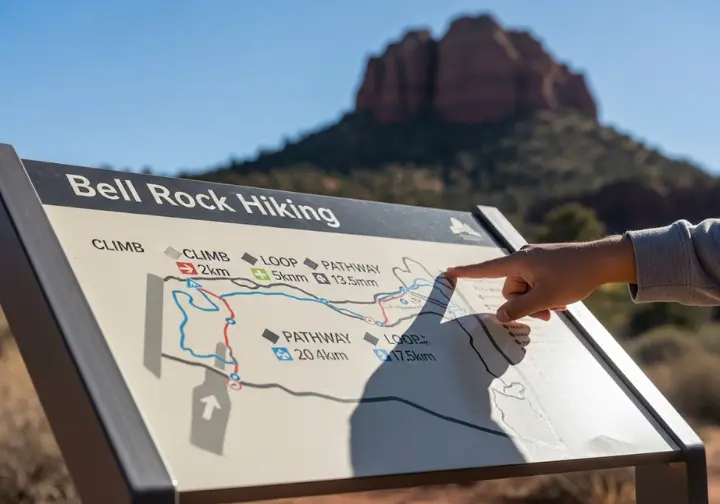
Immediately understanding your different hiking options is key. This clear, easy-to-read comparison table allows you to self-segment based on your ability, interest, and available time, directly answering the core question of “how hard is the Bell Rock hike?”
Bell Rock & Courthouse Butte Hikes
Choose the right adventure for your skill level.
Bell Rock Climb (Upper)
Best for experienced hikers and scramblers seeking direct vortex energy and panoramic 360° views.
Courthouse Butte Loop
Best for hikers of all levels and photographers, offering varied desert landscapes and changing views.
Bell Rock Pathway
Best for casual walkers, families with strollers, and mountain bikers on a wide, accessible surface.
Planning Your Visit: Parking, Passes & Logistics
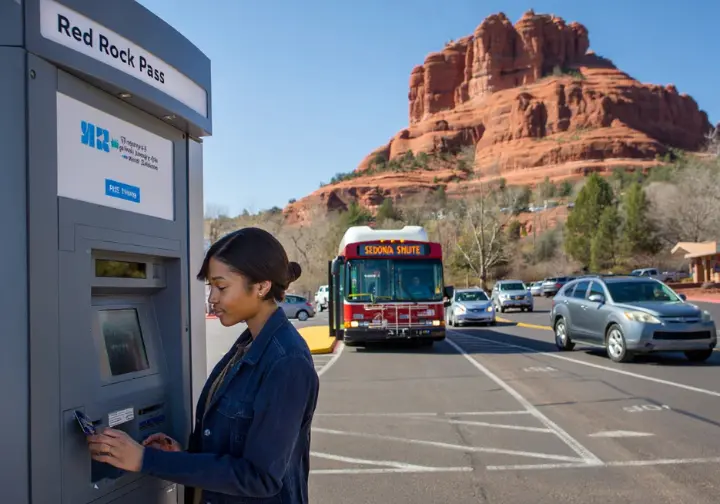
A fantastic day hike at Bell Rock begins long before you reach the trailhead. A strategic deep dive into the most significant logistical hurdles—parking and the Red Rock Pass system—provides exceptional practical value. Our clear, actionable solutions are designed to build your confidence and streamline your planning for any of the hikes in this park.
The Parking Challenge: An Access Strategy Guide
Parking is the number one point of friction at Bell Rock. The two primary lots—the Courthouse Vista (North) lot and the larger Bell Rock Vista & Trailhead (South) lot—fill up extremely early, especially on weekends and during peak season. The Courthouse Vista rock trailhead is the preferred start for the Bell Rock Climb, while the Bell Rock parking at the south lot better serves the Pathway and the Loop trail.
Your best strategy is to arrive a little after sunrise for the best chance at a spot. If the main lots are full, the Yavapai Vista Trailhead is a viable overflow option, connecting to the Bell Rock access trail system via a 0.5-mile path.
Honestly, the best solution is to use the free Sedona Shuttle service. It completely bypasses the parking chaos. A major advantage is that a Red Rock Pass is not required for your vehicle when you use the shuttle, saving you both time and money.
The Red Rock Pass System Explained
A recreation pass, specifically a Red Rock Pass, is required for any vehicle parked at the Bell Rock trailheads. These lots are located within designated fee sites in the Coconino National Forest, managed by the Red Rock Ranger district. For 2025, the pass options are a Daily Pass for $5, a Weekly Pass for $15, or an Annual Pass for $20. Passes can be purchased at trailhead kiosks with a credit card, or purchased in advance at Recreation.gov.
It’s vital to understand what the pass does and does not cover. The Red Rock Pass and the America the Beautiful Pass are not valid at private concessionaire sites like West Fork or at Arizona State Parks like Slide Rock, which have their own separate entrance fees. Understanding this distinction can prevent confusion and unnecessary purchases.
To clarify, here is how the passes compare:
| Pass Name | Cost (2025) | Validity | Where It Works |
|---|---|---|---|
| Red Rock Daily Pass | $5 | 1 Day | Red Rock Ranger District fee sites |
| Red Rock Weekly Pass | $15 | 7 Consecutive Days | Red Rock Ranger District fee sites |
| Red Rock Annual Pass | $20 | 1 Year | Red Rock Ranger District fee sites |
| America the Beautiful | $80 | 1 Year | National Parks & Federal Lands (incl. Red Rock District) |
The Best Time to Hike Bell Rock
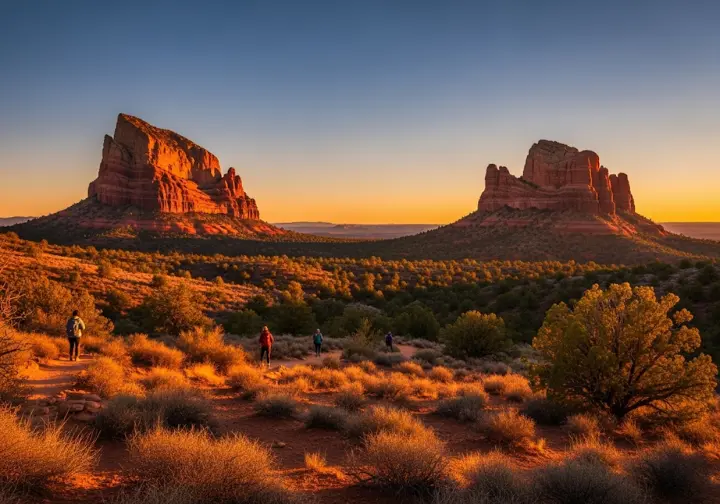
Timing your visit correctly can make the difference between a pleasant hike and a sweltering ordeal. Consider these key factors for seasonality, time of day, and crowd levels to ensure you have the most enjoyable and comfortable experience possible on the trail, especially in the spring.
Seasons, Weather, and Crowds
The prime seasons for hiking in Sedona are spring (March-May) and fall (September-November), offering mild temperatures and beautiful conditions. For those seeking solitude, visiting in the winter is an excellent alternative with fewer people and the chance of a dusting of snow on the red rocks. We strongly advise against hiking in the summer (June-August) when temperatures often exceed 90°F on trails with very little shade.
To avoid both the heat and the biggest crowds, start your hike early in the morning or late in the afternoon. Sunrise and sunset are premium times for photography, casting a spectacular “golden hour” light on the formations. Be prepared for company; this popular trail is one of the most heavily trafficked areas in Sedona, especially on weekends.
The Hikes: A Multi-Level Trail Guide
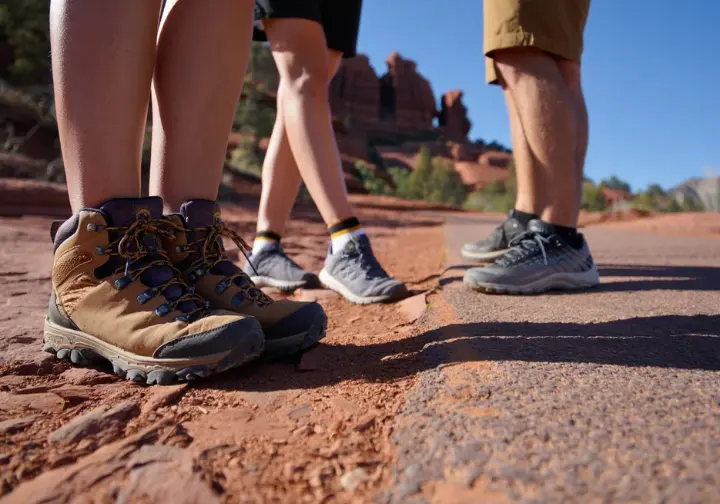
Diving into the trail details is the heart of any hiking guide. Here you’ll find practical descriptions of the three primary hiking experiences. This allows you to explore the specific trail that matches your chosen adventure—from a steep hike to a flat hike—with a heavy emphasis on navigation, safety, and managing expectations.
The Bell Rock Climb (For the Adventurous)
This is the most challenging option at Bell Rock, a true rock scramble up the formation’s northern face. It’s a steep hike, not a simple walk-up trail. The ideal starting point is the Courthouse Vista Trailhead North. From there, follow the wide Bell Rock access trail towards the base of the rock. As you begin to ascend, look for the wire-mesh rock baskets (gabions) that act as cairns, marking the general route over areas of bare slickrock. These markers become sparse higher up, requiring solid route-finding skills, some light bouldering, and the right proper footwear for the scramble.
It is absolutely critical to distinguish between the two “summits.” The main, marked trail leads to a large, flat rock platform often called the “Hiker’s Summit.” This is a Class 1-2 scramble with a steep incline, and it’s the safe, logical endpoint for 99% of visitors.
The true, tippy-top summit, or “Climber’s Summit,” is a different beast entirely. Reaching it is a hazardous, semi-technical endeavor—a Class 4-5 rock climb with serious exposure, only for experienced rock climbers with gear. People have tragically died attempting these steep climbs. Know your limits and enjoy the spectacular red rock views from the Hiker’s Summit.
The Courthouse Butte Loop (For the Scenic Hiker)
For an immersive red rock experience without a difficult vertical scramble, this loop trail is your best choice. At approximately 3.6 to 4.2 miles with a gentle 350-400 foot elevation gain, it’s an easy-to-moderate hiking trail and a great choice for beginner hikers. The route circumnavigates both Courthouse Butte and Bell Rock, offering constantly changing perspectives of these massive red rock formations. It’s considered one of the great hikes in the region.
You can start from either the Courthouse Vista or Bell Rock Vista lot and hike in either direction. We find that a counter-clockwise direction tends to offer slightly more dramatic views as you approach the buttes and nearby spires. The scenery is classic high desert, taking you through pinyon and juniper woodlands and open meadows with distant views of landmarks like Cathedral Rock. A portion of this trail enters the federally designated Munds Mountain Wilderness, where mechanized travel like mountain bikes is prohibited.
The Bell Rock Pathway (For the Casual Walker & Family)
The Bell Rock Pathway is the most accessible trail in the network, making it a fantastic option for a wide range of visitors, including inexperienced hikers. At 3.6 miles, its surface is a wide, hard-packed, and sometimes paved gravel trail, making it suitable for a casual walk and even some rugged strollers. This trail is perfect for those looking to start hiking as a new activity. The official trail name is clear on all signs.
This is a multi-use trail and a popular mountain biking route, so expect to share it with cyclists and be courteous. The primary benefit of the Bell Rock Path is that it provides fantastic, easy-to-reach views of the main rock formations without any scrambling or significant physical effort. It’s a wonderful way to experience the grandeur of the landscape up close.
The Bell Rock Vortex: A Complete Guide
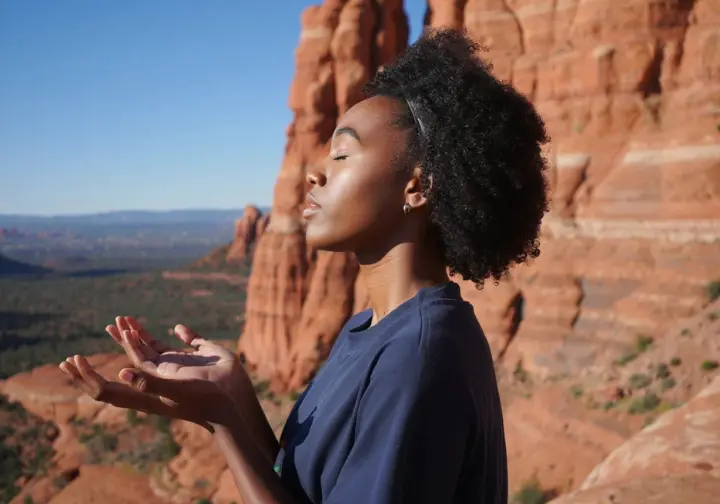
The spiritual dimension of Bell Rock is a major draw for many visitors on a tour of Sedona’s energy centers. It’s a topic worth addressing with intellectual honesty, covering the history, the beliefs, and the scientific counterpoints to serve all readers, regardless of their perspective on the matter.
History and The “Masculine Energy” Concept
A common misconception is that the vortex concept is rooted in ancient Native American lore. While the land is sacred to indigenous peoples, the specific “vortex” locations and their terminology were popularized in the 1980s by a New Age psychic named Page Bryant. She claimed her spirit guide, “Albion,” identified these energy centers, and the idea gained widespread fame during the Harmonic Convergence event of 1987.
Within this framework, Bell Rock is considered a “masculine” or “upward-flowing” vortex. This type of energy is believed to be empowering. Proponents feel it aids in decision-making, strengthens assertiveness, and helps one solve problems from a higher spiritual perspective. This is often contrasted with the “feminine” or “inward-flowing” energy found at sites like Cathedral Rock, which is associated with introspection and gentleness.
The Vortex Experience: Belief vs. Skepticism
Those who believe in the vortexes report a range of subjective physical and emotional sensations. These can include tingling skin, a feeling of vibration or humming, sudden emotional releases, or a sense of profound peace and mental clarity. Many people find the experience to be deeply moving and spiritually significant, especially near the rock’s base or the small cave-like alcoves.
From a skeptical perspective, there is no measurable evidence to support the existence of unusual energy fields at these sites. Scientific explanations for the positive feelings people report often point to the placebo effect, the power of suggestion, and the well-documented psychological benefits of spending time in awe-inspiring natural environments. The commonly cited “proof” of twisted juniper trees is a normal botanical phenomenon called phototropism, caused by wind and the pursuit of sunlight, and is not unique to vortex sites.
A Photographer’s Guide to Bell Rock
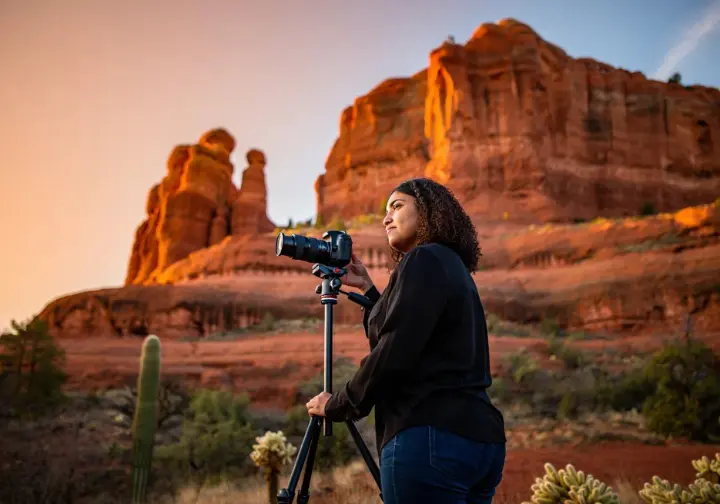
Countless photographers are drawn to Bell Rock’s dramatic form and the surrounding canyon landscape. Moving beyond generic tips, our mini-itinerary and technical guidance can help you capture world-class images of this iconic butte.
Best Light, Locations, and Compositions
The best light for photography occurs during the “golden hours”—the first hour after sunrise and the last hour before sunset. This warm, low-angle light creates beautiful colors and dimensional shadows on the ridgeline. The “blue hour,” just before sunrise and after sunset, also offers unique photographic opportunities. For a classic sunrise shot of both buttes, we recommend the view from the Yavapai Vista Trailhead. For sunset, a spot on the eastern side of the Courthouse Butte Loop allows you to capture the fiery glow on Courthouse Butte itself.
The first major plateau on the Bell Rock Climb is the ultimate location for stunning panoramic, 360-degree vistas. A powerful compositional tip is to use the winding trails of the Pathway or Loop as leading lines, drawing the viewer’s eye into the scene towards the main rock formations. For more tips for backpacking with camera gear, our dedicated guide can help you pack smart.
Hiker Preparedness & Responsibility
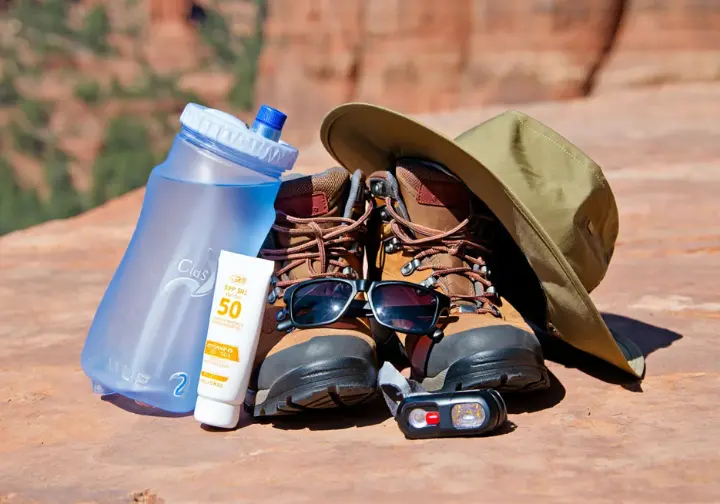
As dedicated senderistas, we believe in being prepared and hiking responsibly. Emphasizing the essential practices tailored to the specific challenges and incredible fragility of the Sedona desert wilderness is critical. These are not just suggestions; they are crucial for your safety and the preservation of this landscape.
Essential Gear for Bell Rock
Footwear is non-negotiable. Sturdy hiking boots or hiking shoes with sticky rubber soles are mandatory for the Bell Rock scramble. For the Loop or Pathway, good trail runners are sufficient. Hydration is also critical in this dry, exposed environment with high elevation. Plan on carrying a minimum of 1-2 liters of water per person, even for short hikes, and more in the summer.
Sun protection is essential year-round due to the elevation. A wide-brimmed hat, sunglasses, and high-SPF sunscreen are must-haves. Finally, if you plan a sunrise or sunset hike, a reliable headlamp (not your phone’s flashlight) is a critical piece of safety gear for navigating the descent in low light. These items are part of the core essentials for any day hike.
Leave No Trace: The Sedona Edition
In a place as popular and ecologically delicate as Sedona, practicing Leave No Trace principles is not just good etiquette; it’s a critical responsibility for every visitor. One of the most important local principles is to Travel on Durable Surfaces. The dark, crusty soil you see is not dirt; it’s a living organism called cryptobiotic crust that is vital to the desert ecosystem and can be destroyed by a single footstep. Please, follow trail signs and stay on marked trails.
Another vital rule is to Leave What You Find. Specifically, do not build your own rock cairns. These unauthorized stacks can mislead other hikers, interfere with official navigation markers, and cause people to get lost. Of course, always pack out everything you pack in—including food scraps like orange peels that take years to decompose in this arid climate. And as always, the first principle is to Plan Ahead and Prepare, which includes checking for current fire restrictions before you go.
Key Takeaways for Your Bell Rock Hike
Your adventure to this Sedona icon should be memorable for all the right reasons. By keeping a few key points in mind, you can ensure a safe, responsible, and incredible experience on the Bell Rock hiking trail.
- Choose Your Hike Wisely: The most important step is matching the trail to your group’s ability. Use our at-a-glance table to decide between the challenging Scramble, the scenic Loop, or the accessible Pathway before you arrive. This could be your first hike or your fiftieth; there’s a good option for you.
- Logistics Are Not Optional: Arrive very early to secure parking. Even better, make the free Sedona Shuttle your primary plan to completely avoid parking-related stress and the need for a pass.
- Be Desert Prepared: This means carrying more water than you think you need, having robust sun protection, and wearing proper footwear—especially hiking shoes with excellent grip for the scramble.
- Hike Responsibly: Protect this fragile landscape by staying on marked trails to avoid damaging the delicate cryptobiotic soil. Do not build your own rock cairns, as this can endanger other hikers.
- Whether you seek a physical challenge, a spiritual connection, or simply a beautiful walk in a world-class setting, a well-planned trip towards Bell Rock offers an unforgettable experience.
Frequently Asked Questions about Hiking Bell Rock
How difficult is it to climb Bell Rock? +
Do I absolutely need a Red Rock Pass to hike at Bell Rock? +
Which parking lot is the best one to use? +
Where exactly is the Bell Rock vortex? +
We are a participant in the Amazon Services LLC Associates Program, an affiliate advertising program designed to provide a means for sites to earn advertising fees by advertising and linking to Amazon.com. As an Amazon Associate I earn from qualifying purchases. We also participate in other affiliate programs. The information provided on this website is provided for entertainment purposes only. We make no representations or warranties of any kind, expressed or implied, about the completeness, accuracy, adequacy, legality, usefulness, reliability, suitability, or availability of the information, or about anything else. Any reliance you place on the information is therefore strictly at your own risk. Additional terms are found in the terms of service.



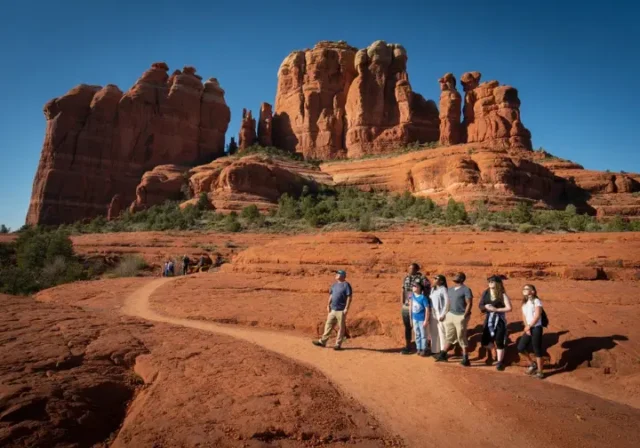
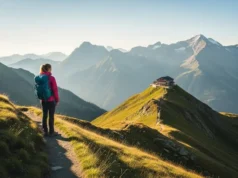




![Trek Budgeting: A Data-Backed Guide [+ Free Template] A trekker sits at a desk planning a trip budget on a laptop, with a stunning view of the Himalayan mountains visible through a window behind them.](https://thehikingtribe.com/wp-content/uploads/2025/07/00-trek-budgeting-data-backed-planning-100x75.webp)

